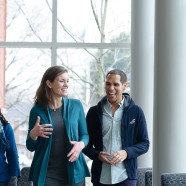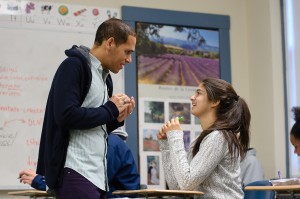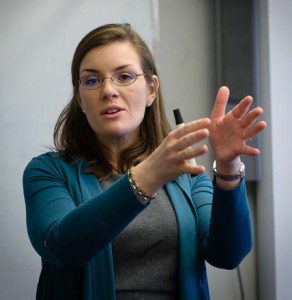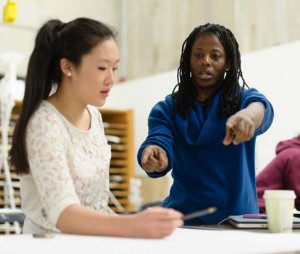
You won’t catch Lydia Thorp walking. If she runs she can get where she needs to be on campus, just barely. Lydia has taught Spanish at Milton since 2010, and she lives in Millet House. Twice each week she also attends classes taught by new Milton faculty members. She sits alongside students taking Spanish III with José Benítez-Meléndez; and she leans on the art tables with students in the Drawing course that Jenny Hughes teaches. Each week Lydia also meets with José and with Jenny separately, so they can talk about what she observed. Chiseled out of schedules that are famously tight, a new mentoring program links eight veteran Milton teachers with 14 teachers new to the School for work over several years. In year one, they spend their most significant time observing one another and reflecting on what they see.
Launched this year, Milton’s Mentor Program deliberately creates a non-evaluative space for new faculty to ask questions, talk honestly about teaching, and learn about the School.
A week’s chronicle
José’s smile is as wide as the classroom door; he greets each of his students in Spanish, with a separate comment. The moment they’re seated he moves them into a discussion, completely in Spanish, about travel and vacations. Through quick “Q&A,” reacting and playing off their answers, José records words, phrases, concepts. His follow-up questions generate more — about logistics, people, what happens at the airport. Once their web of words consumes the whiteboard space, José sets up a quiz game. Teams of three: two kids sit facing the class; a third stands, facing his teammates. The standing team member must give apt enough clues (in Spanish, of course) that his teammates successfully guess a particular word. The clock is ticking. Teammates rotate sitting and standing. Five teams of three keep the game hopping. One team will ultimately win. The students are invested — anticipating their own team’s turn; watching the cues; guessing the right word; keeping track of the score. José closes the class with a worksheet. The pulse of the class never falters.
 Lydia watches, smiles, take notes continually. Using a chart, she tracks the progress and timing of elements within the class (travel vocabulary build-out; quiz game gamble; worksheet closure). She records José’s techniques, his interaction with students (who speaks, how often, who doesn’t). She notes how students arrange themselves in the room: Can José connect visually with each student? She and José have already discussed his objective for this class, so she notes what happens compared to what he had planned. In follow-up classes, José plans to build organically toward the grammar and usage complexity involved in the concepts they launched together today.
Lydia watches, smiles, take notes continually. Using a chart, she tracks the progress and timing of elements within the class (travel vocabulary build-out; quiz game gamble; worksheet closure). She records José’s techniques, his interaction with students (who speaks, how often, who doesn’t). She notes how students arrange themselves in the room: Can José connect visually with each student? She and José have already discussed his objective for this class, so she notes what happens compared to what he had planned. In follow-up classes, José plans to build organically toward the grammar and usage complexity involved in the concepts they launched together today.
“I’ve always looked for feedback,” José says. “I like concrete facts. They give me constructive feedback; general comments do not. For instance, I’d like comments about my writing on the board, how I communicate the definition of a word, the pace of the class, to what extent students were involved, and did the material and the activities vary enough.
“I want feedback from students as well,” he says. “I’m impressed at Milton’s willingness to get students’ feedback. I’d like to know what they think of the homework, whether they like the stories we’re reading, whether the pace of the course is okay. They might tell me, for instance, ‘It’s okay for honors; a little fast for non-honors level.’”
“Getting to know the academic culture of the School, the expectations within this environment — mentors can help,” Lydia explains. “Going into this, I anticipated explicitly observing teaching and learning. Often other things come up too, part of teachers’ daily lives that affect their teaching, assumptions you don’t realize you make if you’ve worked here for a while. For instance, what it means to live in the dorm and interact with students day and night; or comment writing; or particular idiosyncracies of the Milton schedule.
 “José planned the vocabulary lesson to stage his teaching of the grammar,” Lydia explains. “His methodology is more organic, whereas I use a kind of ‘equation’ format to help kids understand grammar. It will be interesting for both of us to see which students respond to each of these two approaches, as we observe one another over time. I document what José’s process was, and I watch for a general gauge of students’ reaction to the material and the process. I take note, too, of whether any kids drifted off into their own conversations, and how consistently they seemed to focus on what was happening. Clearly, doing this with José makes me reflect intensely on my own practice.”
“José planned the vocabulary lesson to stage his teaching of the grammar,” Lydia explains. “His methodology is more organic, whereas I use a kind of ‘equation’ format to help kids understand grammar. It will be interesting for both of us to see which students respond to each of these two approaches, as we observe one another over time. I document what José’s process was, and I watch for a general gauge of students’ reaction to the material and the process. I take note, too, of whether any kids drifted off into their own conversations, and how consistently they seemed to focus on what was happening. Clearly, doing this with José makes me reflect intensely on my own practice.”
Jenny Hughes is slight, relaxed and soft-spoken. Without raising her voice, she owns every student’s attention as she reviews the project they’ve undertaken. Each one is developing a poster, an ad, a book or a DVD in Photoshop for printing in large format. They work from an image, a drawing or a photo (their own, or one they’ve found online); they conceive a plan, then use attributes in Photoshop to design an original treatment. It cannot be a reflection of some other promotional material or image that already exists. Students move from the art table to desktop computers in the digital design lab. Some students are Photoshop “pros”; some are Photoshop-phobic. Each student dives in, and different types of individual requests pop up quickly: One boy needs an explicit explanation; someone else needs an approach to a technical problem; another is looking for an interim critique. Jenny moves around the room, responding calmly and thoroughly, person by person. Regardless of a student’s starting place, Jenny helps him or her gain the ground that makes an independent follow-up step possible. One student, for instance, was having trouble moving her drawing from her email inbox to Photoshop so she could work with it. Jenny ultimately got a camera and reshot the image, saved it to the hard drive where the student was working, and helped
her browse to find it and move it into Photoshop. Students ask one another for help as well. They all seem to know who can help with what. Their project choices are diverse: a poster advertising an NFL game; a highway sign to advertise a movie; a book cover designed around the profile images of the characters; and an ad for Planet of the Apes, creating a visual treatment from a tiny element of the original promotion. In one class, Jenny needed to be an unflappable resource, teaching general digital skills, Photoshop application specialties, design considerations, and artistic conceptualization.
 Once Jenny had launched the class, Lydia walked around the room, noting the number and pace and range of questions from and responses to students. She observed the designers at work, watching to see how each was making progress independently. Lydia drew a “map” of the work stations in the room and numbered the students so she could keep track, for Jenny, of which students asked how many and what kind of questions during class.
Once Jenny had launched the class, Lydia walked around the room, noting the number and pace and range of questions from and responses to students. She observed the designers at work, watching to see how each was making progress independently. Lydia drew a “map” of the work stations in the room and numbered the students so she could keep track, for Jenny, of which students asked how many and what kind of questions during class.
Like José, Jenny was eager for what Lydia’s observation could bring to light. Boys asked fewer questions, it turned out, although all the students wanted Jenny’s help, from the experienced kids to the novices. The two teachers looked at Lydia’s map and the patterns of interaction. “As a department, we’re working on integrating art and technology,” Jenny says. “This project puts the two together, and we’ll see how the differences in Photoshop familiarity work out. Once we know, we can stay with this plan, or consider giving students several smaller projects that build to this larger one. Or, I could present Photoshop tools in one class — how to add text, enlarge or size down, select and erase color. Each person would have to learn quickly, but at least everyone would have the basics when we started the project.”
Lydia went on to ask Jenny about the status of her advisees. They had been talking over the semester about effective supportive steps for different students. They rounded out their meeting by previewing the challenge of Milton’s January schedule. “I know I’m always surprised at how quickly we move from break, through to review, to exams,” Lydia said, “and I thought you might want to think about how the month would go.”
Observation is frequent and steady (at least once, weekly) and the debriefing meetings follow at the same rhythmic pace. Those logistics are one key element, and new skills are another. Milton mentors reflexively start observing by relying on how they have been observed in the past, and that was mostly for their own evaluations, Lydia explains. Training for the mentor team, which happens both on and off campus, redefines observation. “You need to begin with a clear understanding of what a teacher’s specific objective is for a class,” Lydia says. Natural tendencies to critique or praise, or both, need to be refocused on a different kind of attention, recording and reviewing. Mentors also learn about instructional coaching, goal setting, diversity, and Milton’s recently crafted “Principles of Teaching and Learning.”
“We learn so much from each other,” Lydia says frequently. “Across disciplines, levels, vastly different kinds of learners, and diverse teaching strategies, the growth that goes on is absolutely reciprocal.” These teachers seem to have a tactile feel for each other’s styles and motivations, energy and ways of connecting with kids. Their meetings give them insight into how a particular person parses a teaching challenge and plans to approach it. Each of them learns how that effort worked, in real time. They can help one another be aware of the socio-cultural issues active in teenagers’ lives, their fears, their expectations about their own competencies, or how they understand risk.
Observation by your colleagues is a luxury; teachers know that. It’s also a nearly invaluable asset; a discrete skill; and a powerful motivator for growth. The bonus, when veteran and newer teachers observe one another, is reciprocal growth. That was fully anticipated — now it’s being fully appreciated.
by Cathleen Everett



